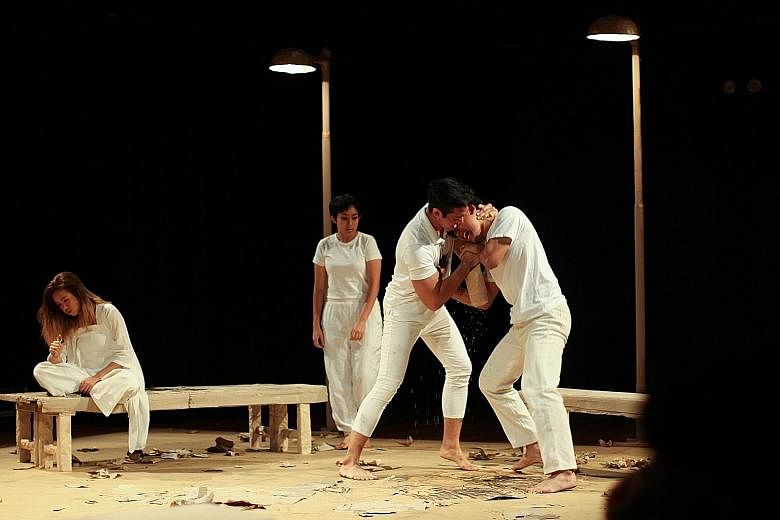REVIEW / THEATRE
ANAK MELAYU
Teater Kami
Malay Heritage Centre/Last Friday
When Noor Effendy Ibrahim wrote and staged Anak Melayu (Malay Child) for Teater Kami in 1992, the graphic language and sexually explicit performance shocked viewers so much that the Criminal Investigation Department had to look into the matter.
Nearly 30 years later, older theatregoers are used to various styles of performance. Director Adib Kosnan, who was too young to watch the first staging, uses visuals and sounds instead to enhance the emotional punch of the script in this production.
Rap blares defiance as six teenagers, played by Tysha Khan, Fadhil Daud, Amirah Yahya, Masturah Oli, Hafiz Hanafi and Mish'aal Syed Nasar, appear in an outdoor location constructed of cardboard. The material is associated with the poorest in Singapore, who often make a living from recycling scraps.
Cardboard covers every stage element, from streetlights to skateboard to park bench, pointedly illustrating where these characters exist in the social hierarchy.
The cast wears pure white - at first glowing against the beige background, challenging the poverty of their setting. But as the narrative continues, charcoal wielded by a struggling artist smears and darkens the purity of the characters' clothes. Life grinds away at their potential, leaving them almost indistinguishable from the impoverished setting at the end.
Anak Melayu, which ended its run last Saturday, was all too relevant despite the age of the production. Effendy's script screams rage and this cast embodies a suppressed, despairing anger that so many adults would easily file away as the behaviour of "bad" kids who are beyond all hope.
But are they indeed? Why are they the way they are?
The artist (a riveting Mish'aal) scribbles away in a desperate attempt to make sense of his origins and come to terms with his future.
The self-styled leader of the group, Joe (Fadhil), is always ready for a fight and to drag others down to his level because that is the only way he can accept his own powerlessness in the larger scheme of things.
The women are reduced to their sexuality, but are not pitiful. Their bodies are weapons and will be deployed to cement their position in this social hierarchy.
All six characters are desperate for connection and also snarl if any of the others point out their vulnerability.
Attempts are made by the oldest, Liza (a competent and believable Amirah), to protect the others, but in the end, she gives up in silent acceptance of the futility of her attempts.
Lights dim as the youngest, Yati (well played by Tysha), takes her first taste of a cigarette and no one stops her. The despair is palpable, the rage rising in the audience's hearts. Someone should have stepped in to help this child.
She is everyone's child, not someone else's problem.


